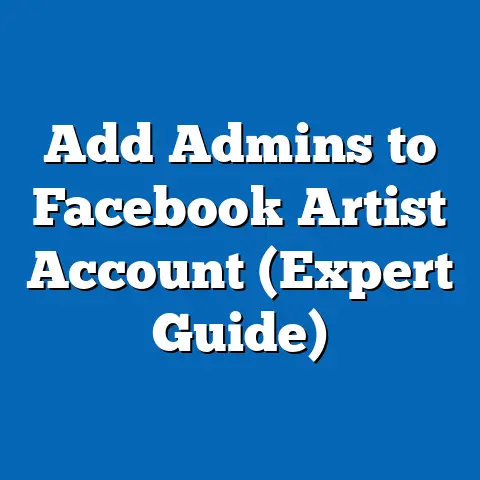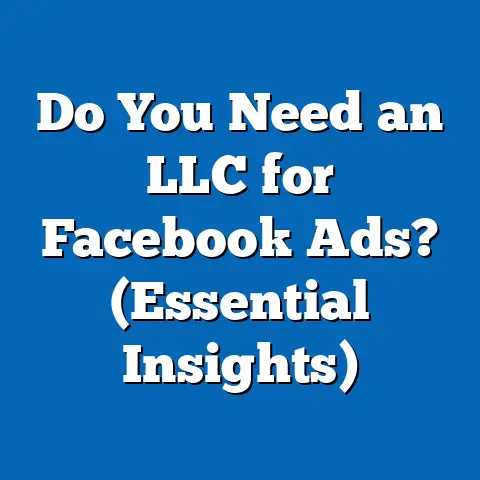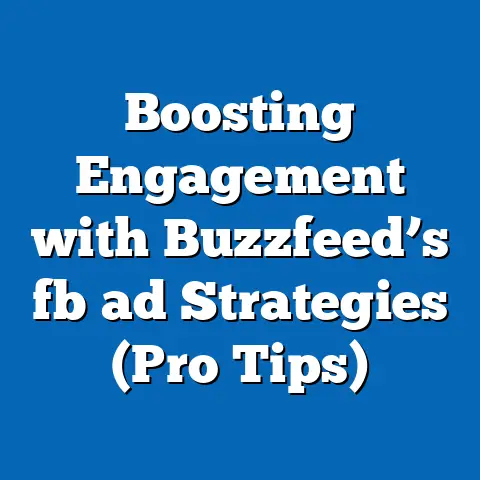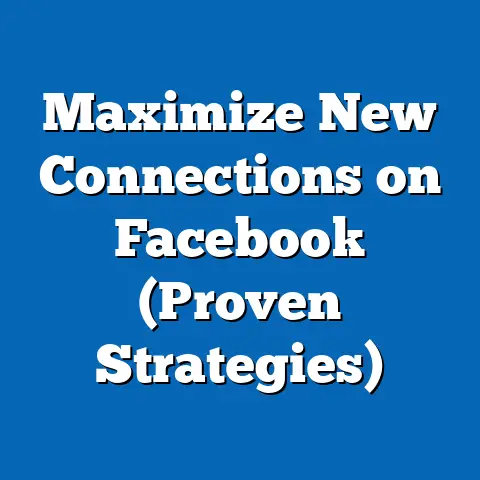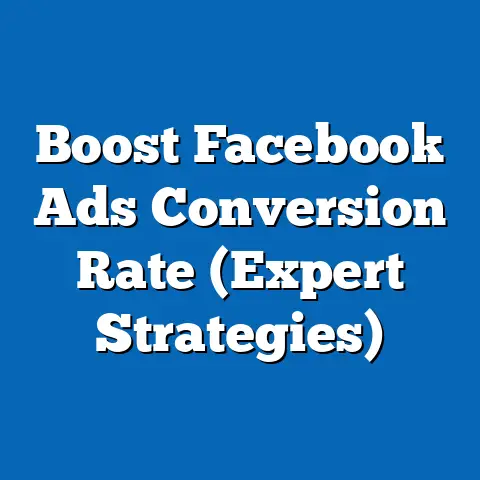Unlock Top Facebook Ad Leads (Proven Conversion Strategies)
Facebook advertising. It’s a phrase that can either excite you with the possibilities of reaching millions or fill you with dread at the thought of another marketing expense. But what if I told you that Facebook ads could be one of the most affordable and effective ways to generate high-quality leads for your business?
I’ve seen firsthand how businesses, both big and small, have transformed their lead generation efforts through strategic Facebook advertising. It’s not just about throwing money at the platform; it’s about understanding the nuances, crafting compelling campaigns, and continuously optimizing for maximum ROI. In this guide, I’ll walk you through proven conversion strategies that can help you unlock the potential of Facebook ads without breaking the bank.
Understanding Facebook Ads
Let’s start with the basics. Facebook ads are paid messages that businesses use to reach a specific audience on the Facebook platform. Unlike organic content, which is only seen by your existing followers (and even then, not always!), ads allow you to target users based on their demographics, interests, behaviors, and more.
Think of it this way: Imagine you own a local bakery specializing in gluten-free treats. Instead of relying solely on word-of-mouth or traditional advertising like newspaper ads, you can use Facebook ads to specifically target individuals in your area who have shown an interest in gluten-free diets, healthy eating, or local bakeries. This targeted approach significantly increases the likelihood of reaching potential customers who are genuinely interested in your products.
There’s a wide variety of Facebook ad formats to choose from, each with its own unique benefits:
- Image Ads: These are simple, visually appealing ads that feature a single image or video. They’re great for showcasing your products or services in an eye-catching way.
- Video Ads: Video ads are incredibly engaging and can be used to tell a story, demonstrate a product, or provide valuable information. They’re particularly effective for capturing attention in the crowded newsfeed.
- Carousel Ads: Carousel ads allow you to display multiple images or videos within a single ad unit. This is a fantastic option for showcasing a range of products, highlighting different features, or telling a sequential story.
- Collection Ads: Designed specifically for mobile users, Collection ads combine a cover image or video with a selection of related products. They offer a seamless shopping experience and are ideal for e-commerce businesses.
- Lead Ads: These ads are designed specifically for lead generation. They allow users to submit their contact information directly within the Facebook platform, making it incredibly easy for them to express interest in your products or services.
Now, let’s talk numbers. Facebook boasts over 2.9 billion monthly active users, making it the largest social media platform in the world. According to Statista, in 2023, the average engagement rate per Facebook post was around 0.09%. While this might seem low, remember that this is an average across all types of content. With strategic targeting and compelling ad creatives, you can significantly increase your engagement rates and generate a steady stream of high-quality leads.
Key Takeaway: Facebook ads offer a powerful and versatile way to reach a targeted audience and generate leads. Understanding the different ad formats and leveraging the platform’s massive user base is crucial for success.
Setting Clear Goals and Understanding Your Audience
Before you even think about creating your first ad, it’s crucial to define your advertising goals. What do you want to achieve with your Facebook ads? Are you looking to increase brand awareness, generate leads, drive sales conversions, or something else entirely?
Having a clear goal in mind will help you tailor your ad copy, visuals, and targeting options for maximum impact. For example, if your goal is to generate leads, you’ll want to focus on creating compelling offers and using lead ad formats that make it easy for users to submit their contact information.
Once you’ve defined your goals, it’s time to understand your audience. Who are you trying to reach with your ads? What are their demographics, interests, behaviors, and pain points?
Facebook offers a wealth of targeting options that allow you to narrow down your audience with incredible precision. You can target users based on:
- Demographics: Age, gender, location, education, job title, and more.
- Interests: Hobbies, passions, and topics they’ve shown an interest in on Facebook.
- Behaviors: Purchase history, online activity, and other behaviors that indicate their likelihood of being interested in your products or services.
- Custom Audiences: You can upload your own customer data (e.g., email lists, phone numbers) to create custom audiences and target your existing customers or lookalike audiences based on their characteristics.
- Lookalike Audiences: Facebook can create lookalike audiences based on your existing customers or website visitors. These audiences are composed of users who share similar characteristics and behaviors as your best customers, making them highly likely to be interested in your products or services.
To truly understand your target audience, I recommend creating buyer personas. A buyer persona is a semi-fictional representation of your ideal customer, based on research and data about your existing customers.
For example, let’s say you’re selling online fitness programs. Your buyer persona might look something like this:
- Name: Sarah
- Age: 35
- Occupation: Marketing Manager
- Location: Suburban area
- Goals: To lose weight, get in shape, and improve her overall health.
- Pain Points: Doesn’t have time to go to the gym, feels overwhelmed by conflicting fitness information, and struggles to stay motivated.
- Interests: Healthy eating, yoga, running, and online fitness communities.
By creating detailed buyer personas, you can gain a deeper understanding of your target audience and tailor your ad content to resonate with their specific needs and desires.
Key Takeaway: Setting clear advertising goals and understanding your target audience are essential for creating effective Facebook ad campaigns. Leverage Facebook’s targeting options and create buyer personas to ensure your ads reach the right people with the right message.
Crafting Compelling Ad Copy and Visuals
Okay, you’ve got your goals defined and your audience targeted. Now it’s time to craft compelling ad copy and visuals that will grab their attention and entice them to take action.
Your ad copy should be clear, concise, and engaging. It should clearly communicate the value proposition of your product or service and include a strong call-to-action (CTA) that tells users what you want them to do next.
Here are some key elements of effective ad copy:
- Strong Headlines: Your headline is the first thing people will see, so it needs to be attention-grabbing and relevant to their interests. Use strong verbs, numbers, and keywords to make your headlines stand out.
- Clear Value Proposition: Clearly communicate the benefits of your product or service and how it can solve their problems or fulfill their needs.
- Concise Messaging: Keep your ad copy short and to the point. People have short attention spans, so you need to get your message across quickly and effectively.
- Strong Call-to-Action: Tell users exactly what you want them to do next. Use clear and concise CTAs like “Learn More,” “Shop Now,” “Sign Up,” or “Get a Free Quote.”
Your visuals are just as important as your ad copy. High-quality images and videos can capture attention, convey emotion, and showcase your products or services in an appealing way.
Here are some tips for creating effective ad visuals:
- Use High-Quality Images and Videos: Avoid blurry or pixelated images. Use professional-quality visuals that are visually appealing and relevant to your target audience.
- Showcase Your Products or Services: Highlight the key features and benefits of your products or services in your visuals.
- Use Eye-Catching Colors and Designs: Use colors and designs that are consistent with your brand and that stand out in the crowded newsfeed.
- Include Branding Elements: Incorporate your logo, brand colors, and other branding elements to create a cohesive and recognizable brand identity.
Let’s look at some examples of successful ad campaigns that utilized strong copy and eye-catching visuals.
Example 1: Dollar Shave Club
Dollar Shave Club is known for its humorous and irreverent ad campaigns. Their video ads are particularly effective at capturing attention and conveying their brand personality. Their ad copy is also clear and concise, highlighting the value proposition of their subscription service.
Example 2: Airbnb
Airbnb uses stunning visuals to showcase the unique and desirable properties available on their platform. Their ad copy focuses on the experiences that users can have when they travel with Airbnb, rather than just the accommodations themselves.
Example 3: Warby Parker
Warby Parker uses a combination of high-quality product photos and lifestyle images to showcase their stylish and affordable eyewear. Their ad copy highlights the convenience of their online ordering process and the social mission of their company.
Finally, don’t be afraid to A/B test your ad copy and visuals to find the most effective combinations. A/B testing involves creating two or more versions of your ad with slight variations and then running them simultaneously to see which version performs best.
For example, you could A/B test different headlines, images, or CTAs to see which ones generate the most clicks and conversions. Facebook’s ad platform makes it easy to set up and track A/B tests, so there’s no excuse not to experiment and optimize your ad creatives.
Key Takeaway: Crafting compelling ad copy and visuals is crucial for capturing attention and driving conversions. Use clear, concise messaging, high-quality visuals, and strong calls-to-action. Don’t forget to A/B test your ad creatives to find the most effective combinations.
Budgeting and Bidding Strategies
Now, let’s talk money. One of the biggest concerns for small business owners when it comes to Facebook advertising is the cost. But the truth is, Facebook ads can be incredibly affordable, especially compared to traditional advertising methods.
You have complete control over your budget and can set daily or lifetime spending limits. You can start with a small budget and gradually increase it as you see results.
So, how much should you spend on Facebook ads? There’s no one-size-fits-all answer, but here are some general guidelines:
- Start Small: If you’re just starting out, I recommend starting with a small daily budget of $5-$10 per ad set. This will allow you to test different targeting options and ad creatives without breaking the bank.
- Scale Gradually: As you start to see results, you can gradually increase your budget. But be careful not to scale too quickly, as this can negatively impact your ad performance.
- Consider Your Target Audience: The cost of reaching your target audience will vary depending on factors like their demographics, interests, and location. Highly competitive audiences will generally be more expensive to reach.
- Track Your ROI: It’s essential to track your return on investment (ROI) to determine whether your Facebook ads are generating a positive return. If you’re not seeing a positive ROI, you may need to adjust your budget, targeting, or ad creatives.
In addition to setting a budget, you’ll also need to choose a bidding strategy. Facebook offers several different bidding strategies, each with its own pros and cons:
- Cost-Per-Click (CPC): With CPC bidding, you pay each time someone clicks on your ad. This is a good option if your goal is to drive traffic to your website or landing page.
- Cost-Per-Impression (CPM): With CPM bidding, you pay for every 1,000 impressions of your ad. This is a good option if your goal is to increase brand awareness or reach a large audience.
- Cost-Per-Action (CPA): With CPA bidding, you pay only when someone takes a specific action, such as making a purchase or submitting a lead form. This is the most cost-effective option, but it requires more data and optimization.
Which bidding strategy should you choose? It depends on your goals and your budget. If you’re just starting out, I recommend starting with CPC bidding, as it’s the easiest to understand and manage. As you gain more experience, you can experiment with other bidding strategies to see which ones work best for your business.
Key Takeaway: Facebook ads can be incredibly affordable, especially compared to traditional advertising methods. Set a budget that you’re comfortable with, choose a bidding strategy that aligns with your goals, and track your ROI to ensure your ads are generating a positive return.
Utilizing Facebook Pixel for Enhanced Tracking and Retargeting
The Facebook Pixel is a small snippet of code that you can install on your website to track user behavior. It allows you to see which pages people visit, what actions they take, and how they interact with your content.
The Facebook Pixel is essential for several reasons:
- Tracking Conversions: It allows you to track conversions that occur on your website as a result of your Facebook ads. This is crucial for measuring your ROI and optimizing your campaigns.
- Retargeting: It allows you to retarget users who have previously visited your website or interacted with your ads. This is a highly effective way to re-engage potential customers and drive conversions.
- Creating Lookalike Audiences: It allows you to create lookalike audiences based on your website visitors. These audiences are composed of users who share similar characteristics and behaviors as your best customers, making them highly likely to be interested in your products or services.
Setting up the Facebook Pixel is relatively straightforward. You can generate the pixel code from within the Facebook Ads Manager and then install it on your website. Facebook provides detailed instructions on how to install the pixel on various website platforms, such as WordPress, Shopify, and Squarespace.
Once you’ve installed the Facebook Pixel, you can start using it for retargeting. Retargeting involves showing ads to users who have previously interacted with your website or ads.
For example, you could retarget users who visited your product page but didn’t make a purchase. You could show them an ad featuring the product they viewed, along with a special discount or promotion to entice them to complete the purchase.
Here are some effective retargeting strategies:
- Website Visitors: Retarget users who visited your website but didn’t take a specific action, such as filling out a form or making a purchase.
- Ad Engagers: Retarget users who interacted with your ads, such as liking, commenting, or sharing them.
- Video Viewers: Retarget users who watched a certain percentage of your video ads.
- Email Subscribers: Retarget your email subscribers with special offers or promotions.
Key Takeaway: The Facebook Pixel is an essential tool for tracking conversions, retargeting users, and creating lookalike audiences. Install the pixel on your website and start using it to enhance your Facebook ad campaigns.
Analyzing and Adjusting Campaigns for Improved Performance
Finally, it’s crucial to monitor your ad performance and make adjustments as needed to improve your results.
Facebook Ads Manager provides a wealth of data and metrics that you can use to track the performance of your campaigns. Some of the most important metrics to monitor include:
- Click-Through Rate (CTR): The percentage of users who click on your ad after seeing it. A high CTR indicates that your ad is relevant and engaging to your target audience.
- Conversion Rate: The percentage of users who take a desired action after clicking on your ad, such as making a purchase or submitting a lead form. A high conversion rate indicates that your landing page and offer are compelling to your target audience.
- Cost Per Click (CPC): The average cost you pay each time someone clicks on your ad. A low CPC indicates that your ad is cost-effective and efficient.
- Cost Per Acquisition (CPA): The average cost you pay each time someone takes a desired action, such as making a purchase or submitting a lead form. A low CPA indicates that your ad is generating a positive return on investment.
- Return on Ad Spend (ROAS): The amount of revenue you generate for every dollar you spend on advertising. A high ROAS indicates that your ad is highly profitable.
By monitoring these metrics, you can identify areas where your campaigns are performing well and areas where they need improvement.
For example, if your CTR is low, you may need to adjust your ad copy or visuals to make them more attention-grabbing. If your conversion rate is low, you may need to improve your landing page or offer to make them more compelling. If your CPA is high, you may need to adjust your targeting or bidding strategy to make your ads more cost-effective.
The key is to continuously analyze your data and make informed adjustments to your campaigns to improve your performance over time.
Key Takeaway: Monitoring your ad performance and making adjustments as needed is crucial for maximizing your ROI. Track key metrics like CTR, conversion rate, CPC, and CPA, and use this data to optimize your campaigns for improved results.
Conclusion
Facebook advertising offers a powerful and affordable way to generate high-quality leads for your business. By understanding the platform, setting clear goals, crafting compelling ad creatives, optimizing your budget and bidding strategies, utilizing the Facebook Pixel, and continuously analyzing your performance, you can unlock the potential of Facebook ads and achieve significant results.
Remember, optimizing Facebook ad campaigns is an ongoing process. Don’t be afraid to experiment, test new strategies, and make adjustments as needed. The more you learn and adapt, the better your results will be.
So, what are you waiting for? Start implementing these strategies today and share your experiences or successes with Facebook ads in the comments or on social media. I’m excited to see what you can achieve!


